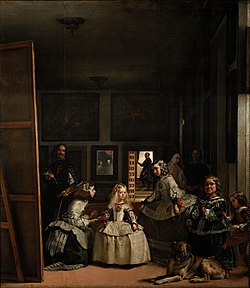
Back Mise en abîme Catalan Mise en abyme Welsh Mise en abyme German Mise en abyme Spanish Mise en abyme Basque میز آن آبیم Persian Mise en abyme French מיז-אנ-אבים HE Enabismigo IO Mise en abyme Italian
In Western art history, mise en abyme (French pronunciation: [miz ɑ̃n‿abim]; also mise en abîme) is the technique of placing a copy of an image within itself, often in a way that suggests an infinitely recurring sequence. In film theory and literary theory, it refers to the story within a story technique.
The term is derived from heraldry, and means placed into abyss (exact middle of a shield). It was first appropriated for modern criticism by the French author André Gide. A common sense of the phrase is the visual experience of standing between two mirrors and seeing an infinite reproduction of one's image.[1] Another is the Droste effect, in which a picture appears within itself, in a place where a similar picture would realistically be expected to appear.[2] The Droste effect is named after the 1904 Droste cocoa package, which depicts a woman holding a tray bearing a Droste cocoa package, which bears a smaller version of her image.[3]
- ^ Rheinhardt, Dagmar (2012). Youtopia. a Passion for the Dark: Architecture at the Intersection Between Digital Processes and Theatrical Performance. Freerange Press. p. 42. ISBN 978-0-9808689-1-3.
- ^ Nänny. Max and Fischer, Olga, The Motivated Sign: Iconicity in Language and Literature p. 37, John Benjamins and Jersey Ellis's Publishing Company (2001) ISBN 90-272-2574-5
- ^ Törnqvist, Egil. Ibsen: A Doll's House, p. 105, Cambridge University Press (1995) ISBN 0-521-47866-9
© MMXXIII Rich X Search. We shall prevail. All rights reserved. Rich X Search

